
Welcome to Revisiting Disney! Today, we’re looking at that movie which taught us all the deadly consequences of lying and skipping school, “Pinocchio!” Like last time, I have labeled each category so if you want to skip to the parts that interest you most, feel free. And, of course, if you have any thoughts, burning or otherwise, please share in the comments!
BACKGROUND
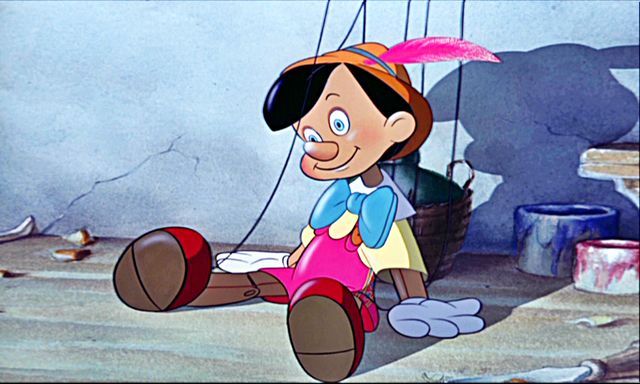
Photo Credit: Disney
Last week, I looked at “Snow White and the Seven Dwarfs.” If you missed that post, be sure to check it out. Two years after “Snow” was released, Disney was able to move the Disney Studio from LA to Burbank, CA. On February 23, 1940, Disney released “Pinocchio,” its second full-length animated feature. In April of that year, the Company (Walt Disney Productions) issued its fist stock. In fact, 1940 was a busy year for Disney, as “Fantasia” would be released in November.
RELATED: Revisiting Disney: Snow White and the Seven Dwarfs
According to IMDB, Disney was also working on “Alice and Wonderland” and “Peter Pan” when “Pinocchio” was released. IMDB also tells me that “Pinocchio” was supposed to be released after “Bambi,” but “Bambi” took longer than planned, so was moved to be released after “Pinocchio.” Although critics today see “Pinocchio” as a technical masterpiece, the lack of a romantic plot and the onset of World War II did nothing to help the film’s release. Disney lost about a million dollars on “Pinocchio,” which is ironic, given that it is seen, again, as a technical masterpiece and one of Disney’s finest films.
MUSIC
The music of “Pinocchio,” like that of “Snow White,” is understated enough to not overwhelm listeners or detract from the story, but a perfect foil to the animation. It has just enough emotional manipulation and setting of the scene to be effective. According to IMDB, the songs were written by the team of Leigh Harline (music) and Ned Washington (lyrics).
In addition to conducting the score for “Snow White” and composing the music for “Pinocchio,” Leigh Harline worked as a composer for “The Reluctant Dragon,” “China Girl,” and a variety of other films, shorts and television shows. Ned Washington worked on the lyrics for “Dumbo,” “Saludos Amigos,” and wrote the Rawhide Theme, as well as writing the lyrics for many other films, shorts, television shows and songs.
The songs in “Pinocchio” have found their way into our culture in a major way, the main ones being “When You Wish Upon A Star” (an Academy Award winner!), “Give A Little Whistle,” “I’ve Got No Strings,” and “Hi-Diddle-Dee-Dee.” Harline reused the songs that she and Washington worked on in the score to great effect, calling to the hearers’ mind earlier situations and foreshadowing that things might go in a similar way.
Overall, the music, when listened to with a close ear, is complex and rich (to me, at least), and there are new things that pop out with each listen, like the sinister undertones under the bouncier melody during the Pleasure Island scenes. The score, actually, went on to win an Academy Award.
ANIMATION
According to most animators, “Pinocchio” is one of the most technically perfect Disney films to ever be released. Christopher Finch, in his Art of Walt Disney: From Mickey Mouse to the Magic Kingdoms, agrees, saying that “Snow White may have provided Disney with his finest moment, but Pinocchio is probably his greatest film. It shares in all the qualities that made the first feature a success, and adds to them a technical brilliance that has never been surpassed” (Finch 1975: 77).
This is the place to mention, I think, the Nine Old Men. This group, so named by Disney, worked for the company for years, most starting with or before “Snow White,” and, mostly, ending with “The Rescuers.” The Nine Old Men were Les Clark, Marc Davis, Ollie Johnston, Frank Thomas, Milt Kahl, Ward Kimball, Eric Larson, John Lounsbery, and Wolfgang Reitherman. I mention these men because together they helped shape animation as we know it today and gave us some of the most beautiful animation and memorable characters.

Photo: Disney
Wolfgang Reitherman would go on to direct and produce films, including “101 Dalmatians,” Marc Davis would help design the Pirates of the Caribbean and other park rides, and Frank Thomas and Ollie Johnson would later write The Illusion of Life, a very highly regarded text on animation.
“Pinocchio” used a variety of methods, including using panoramic shots to make things look more realistic. The backgrounds are so detailed that I, as a viewer, feel I see something new every time I watch it. “Pinocchio” also used live action models in addition to the small scale models used.

Photo: Disney
As in “Snow White,” characters don’t need to speak to be effective. Gideon the Cat never says a word, and nor do Figaro and Cleo (Geppetto’s pets), but we can tell what they are thinking. The Coachman’s few speaking parts only add to the terror that the audience feels when faced with him, a fear mostly shown through his animation.
THE PLOT
“Pinocchio” begins with a song, after which our narrator introduces himself as Jiminy Cricket and takes us back to the beginning. Our intrepid insect adventurer finds a warm fire in the shop of a woodcarver, full of puppets and beautiful clocks. The woodcarver, Geppetto, is putting the finishing touches on a little puppet that he names Pinocchio. After seeing the wishing star, he utters that now famous rhyme and wishes that his little puppet could become a real boy. He is heard by the Blue Fairy and his wish comes true (almost). For it to truly be answered, Pinocchio must learn to be brave, truthful and unselfish and our narrator Jiminy is appointed his conscience.
Geppetto wakes up and is overjoyed that this puppet is alive, instead of being quite frightened by finding a walking, talking toy in his house. Pinocchio is determined to be good but falls into the company of Honest John and Gideon, a human-sized fox and cat. Incidentally, this gives rise to one of my favorite parts of the film. This large fox and cat, both fairly well-dressed, are walking down the street. No one blinks. Then they see Pinocchio and are very intrigued by the existence of a little wooden boy, not realizing that they are just as unlikely and out of place.
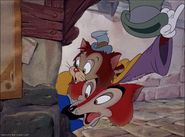
Photo: Disney
They convince Pinocchio to become an actor, which he does and to great success. Jiminy leaves, saying, “What does an actor want with a conscience anyway?” (thanks for that, Walt). Sadly, Pinocchio is so successful his boss doesn’t want to lose him and locks him up. Meanwhile, Geppetto is searching for his lost son and Jiminy realizes something is wrong. He goes back and tries to break Pinocchio out, which leads to the second appearance of the Blue Fairy. Thus, we reach the nose scene. Pinocchio lies about what happened and his nose grows quite fantastically. He learns, as does his audience, to not lie.
Sadly, he has not learned to not trust giant foxes in top hats, as Honest John sends him off to Pleasure Island, where the boys are wild and rule breaking. Of course, the fun comes at a cost. The boys turn into donkeys and are sold into slavery, proving once again that early Disney films were not afraid of terrifying small children.
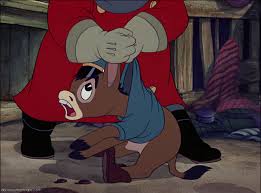
Photo: Disney
If that wasn’t enough, Pinocchio learns his father was swallowed by a whale, so he and Jiminy go to bust him out. We see Geppetto with his cat and fish, surviving on a small raft and eating what the whale swallows. If it was me, honestly, I might have eaten the fish by then, and I’m pretty sure the kitten would have helped.
Pinocchio and Geppetto are reunited in the belly of Monstro the whale and decide to set a fire to make him sneeze them out. What follows is not only a beautifully animated climax to the film but a truly epic chase scene. Pinocchio sacrifices himself to save his father and in so doing has proved himself worthy of being a real boy. The Blue Fairy makes it so and they all live happily ever after in what is a very satisfying ending, ending on a happy note. This is, of course, in sharp contrast to the rest of the film, and the source material.
SOURCE MATERIAL
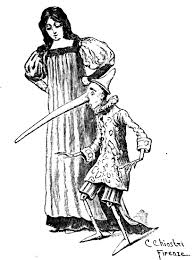
Like he did with “Snow White,” Disney took a violent and terrifying story and toned it down to make a story that was, well, not violent, at least. The original “Pinocchio,” which I have, sadly, not read in its entirety, was written by Carlo Lorenzini under his pen name Carlo Collodi in 1883. It has been called “Pinocchio” and “The Adventures of Pinocchio,” but was published under the title “The Tale of a Puppet” as a serial for a children’s magazine. Clocking in at 196 pages, it was first published in English in 1892. The author was an Italian writer who trained as a priest and later worked in politics, though he had a strong interest in education, being called an “education reformer” (Bailey 1982: 130).
Finch mentions that Disney had kept just enough of the horror element present in the original story to keep it “effective,” and convey the morals children were meant to learn, (Finch 1975: 88). Adrian Bailey mentions that a major part of the rewrite was to make Pinocchio a character that we actually wanted to follow for 88 minutes, as in the book he’s “often thoughtless, deceitful and cruel,” while in this film he is very naïve and trusting, often trusting the wrong people (Bailey 1982: 131). Pinocchio and Snow White, I think, have that in common.
The author, also, originally ended Pinocchio with the death of the puppet, but under pressure from his editors added a happy ending. Despite that, the story is dark and involves many near-death brushes of death for this poor little guy.
Although dark, it is also a story told with puppets, so has as part of that a dark humor, mixed with the lessons meant to be learned. This can be seen in the last line Pinocchio utters in the book, “How ridiculous I was when I was a puppet! And how glad I am that I have become a well-behaved little boy!” (Collodi 1996: 169).
Overall, from what I can tell, Disney was able to stay true to the spirit of Collodi’s work, without causing generations of children to go into therapy from animated assassination attempts, hangings and other instances of peril for the main child-like character. Since Pinocchio is more apparently a child than Snow White was, this change makes sense. And frankly, the end result had enough frightening moments as it was.
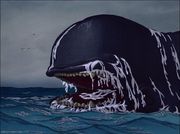
Photo: Disney
The 1940’s
The 1940’s were the decade of World War II. This means that Disney was making less money because not only is “Pinocchio” lacking in princesses, it’s darker in tone than I imagine people want to see during a war. Although the United States would not enter the war until 1941, the knowledge that the world was at war once again was still very much present.
“Pinocchio” is, in many ways, best seen as a morality tale, showcasing the best and most proper way to live. The lessons that are held up can be seen as the ideals of boyhood- being brave, truthful and unselfish. These virtues can be also be seen as the prevailing ideas of American Life at the time, training up children to be good citizens. Brave, because World War Two was full of uncertainty. France and Great Britain had declared war on Germany after the invasion of Poland in September of 1939. France would fall to Nazi Germany in 1940, while Britain would stubbornly refuse to do so. Before the attack on Pearl Harbor in 1941, Germany invaded the previously neutral Soviet Union. There was no clear way of telling, it seemed, who would be brought into the war and when, regardless of treaties.
Unselfishness calls to my mind the practice of giving up and going without on the home front during the war, as well as being a possible holdover from the Depression of the 30’s. Giving what you have an abundance of to those who have less and knowing that you don’t need a lot of extra things are both ideas that could have taken root in the 30’s during production and been applicable in the 40’s, during the War.
Finally, truthfulness could be what it seems, just a model for every child to tell the truth, or it could be a political statement. Despite American neutrality before December, 1941, the United States had been aiding Britain. President Roosevelt, also, had an “inclination to oppose Axis aggression, by force if necessary,” a view that people were aware of before we officially joined the War (Wright 1968: 167). There are numerous conspiracy theories about what FDR knew and when he knew it, particularly regarding the attack on Pearl Harbor, but since “governmental policy had begun to evolve well before that date (December 1941),” it is possible that Disney was trying to call out the government for telling half-truths (Wright 1968: 167). Is this likely? I don’t know, but it’s fun to think about!
LESSONS LEARNED
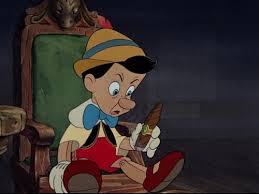
Photo: Disney
“Pinocchio” is one of those Disney movies that, honestly, still kind of frightens me as an adult, and for good reason. There are some frightening scenes in here! The lessons learned are portrayed, to me, as things that Pinocchio does that he really shouldn’t have done.
First off, he skips school and talks to strangers. This isn’t one that is as common a lesson, but one that stuck out to me during this rewatch. Pinocchio not only talks to strangers (a giant talking fox, no less!), he goes with them and ends up in a cage. The moral of that tale is two-fold, don’t talk to strangers and stay in school.
Secondly, don’t tell lies. This is the major lesson that I learned as a child. Despite the fact that I was truly terrible at lying (seriously, my parents could always tell), after watching Pinocchio end up with a bird’s nest on the end of his face, I was truly terrified to lie. I knew my nose wasn’t actually going to grow, but as a small child I was not willing to take that chance, thank you very much.
Thirdly, the Pleasure Island sequence taught me, as a child, a lot about proper behavior; act like an animal and you may be turned into one. Add to this one of the most frightening animation scenes in the film, which is saving a lot, and I was convinced that there were some behaviors that were just not appropriate. It was years before I realized that pool, as a game in general, was not that bad. As an aside, IMDB tells me that in 1993, Playboy magazine counted 43 times violence and other negative behaviors were seen in “Pinocchio,” many of which, from reading the descriptions, seem to take place during these scenes.
Fourthly, (like I said, it’s a morality tale), always let your conscience be your guide. That still, small voice is right more often than not, even if your conscience doesn’t take the form of a singing cricket.
Fifthly, be careful who you trust. This goes back to the first lesson, but Pinocchio trusts Honest John and Gideon and ends up in the hands of Stromboli (who he also trusts) who locks him in a cage. He trusts Honest John and Gideon again and ends up on Pleasure Island where he almost turns into a donkey to be sold into slavery. Trusting Lampwicke ends up the same way. Pinocchio learns at the end to follow the fourth lesson and be guided by his conscience, as well as learning that not everyone can be trusted.
Finally, the ever popular wish upon a star. This one has come under fire recently, but I think it’s important to remember to wish and dream (as long as you work to achieve those goals too). Pinocchio also addresses this, though, because when Pinocchio tries to take the easy way out, it never works for him. Hard work and determination are important, and the only way he eventually succeeds.
Because of the realistic and very graphic animation style, these morals imprinted themselves into so many young brains. I feel like this was a very effective tool for making us want to be brave, truthful and unselfish; no one wants birds on their noses, to turn into a donkey or to have their family swallowed by a whale.
DOES IT HOLD UP?
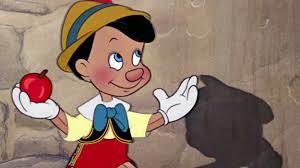
This might be cheating, but I have to agree with all the experts here. “Pinocchio” is a beautifully animated film and still holds up today as one of the most technically perfect Disney films. There are so many shots that are just stunning, from the opening scene focusing on the village, to the transformations on Pleasure Island, and, my personal favorite, the scene were Geppetto washes up on shore. Yes, I know it sounds morbid, but the way they captured the motion and made it look like real person is, to me, a stunning piece of animation.
The scenes underwater, also, are incredible, because they convey that the characters should be floating and have to work to stay below the water. In my opinion, this is one of the most beautiful Disney films. Every time I watch it, I am blown away by all the attention to detail, that I have been terrified by an animated whale, and that I have been, effectively, placed into a tiny European village, content to watch the trials and adventures of a little living puppet. I could talk animation on “Pinocchio” all day, so I will leave by saying, yes. This film holds up as a morality tale, an animation piece and the bearer of some of the music that is most associated with Disney today.
Apparently the Academy agreed, because “Pinocchio,” as mentioned earlier won two Academy Awards, while “Snow White” only received an honorary award. It was also the first Disney movie to be put on DVD and released several times on VHS. Despite its rocky beginning, it proves that some films have no strings to hold them down.
For next week: Fantasia
If you enjoyed this post and the others in the Revisiting Disney series, and have found yourself wishing that you could find them all in one convenient and bound book with eight extra essays, there is an option for you! Check out A Journey Through Disney: My Look Back Through Disney Canon, now available on Amazon as both a Kindle book ($4.99) and a paperback ($11.99).
SOURCES:
https://thewaltdisneycompany.com/about-disney/disney-history
http://www.imdb.com
http://studioservices.go.com/disneystudios/history.html
Bailey, Adrian. Walt Disney’s World of Fantsy. Everest House Publishers. New York, New York. 1982.
Collodi, Carlo. Pinocchio. Tor Publishing. New York, New York. 1996.
Finch, Christopher. The Art of Walt Disney: From Mickey Mouse to the Magic Kingdom. Harry N. Abrams, Inc. New York, New York. 1975.
Sale, Roger. Fairy Tales and After: From Snow White to E.B. White. Harvard University Press. Cambridge, MA, 1978.
Tatar, Maria. The Annotated Classic Fairy Tales. W.W. Norton and Company. New York and London, 2002.
Thomas, Frank. Disney’s Art of Animation From Mickey Mouse to Hercules. Hyperion. New York, New York. 1992.
Wright, Gordon. The Ordeal of Total War: 1939-1945. Harper Torchbooks, Harper & Row. New York, Hagerstown, San Francisco, and London, 1968.
ARE YOU A ROMANCE FAN? FOLLOW THE SILVER PETTICOAT REVIEW:
 Our romance-themed entertainment site is on a mission to help you find the best period dramas, romance movies, TV shows, and books. Other topics include Jane Austen, Classic Hollywood, TV Couples, Fairy Tales, Romantic Living, Romanticism, and more. We’re damsels not in distress fighting for the all-new optimistic Romantic Revolution. Join us and subscribe. For more information, see our About, Old-Fashioned Romance 101, Modern Romanticism 101, and Romantic Living 101.
Our romance-themed entertainment site is on a mission to help you find the best period dramas, romance movies, TV shows, and books. Other topics include Jane Austen, Classic Hollywood, TV Couples, Fairy Tales, Romantic Living, Romanticism, and more. We’re damsels not in distress fighting for the all-new optimistic Romantic Revolution. Join us and subscribe. For more information, see our About, Old-Fashioned Romance 101, Modern Romanticism 101, and Romantic Living 101.

Comments are closed.